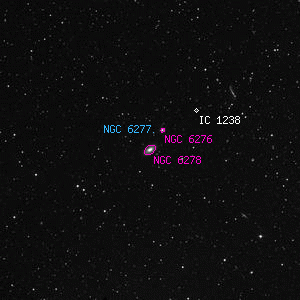NGC 6278

Overlaid DSS image of NGC 6278, 30' x 30' with north at top and west to the right
Aladin viewer for the region around NGC 6278
H III 124, GC 4266, MCG+04-40-011, UGC 10656, PGC 59426, SDSS J170050.32+230039.7
| Type | Galaxy |
|---|---|
| Magnitude | 12.4 |
| Size | 1.37' x 0.767' @ 125° |
| Right Ascension | 17h 0' 50.4" (2000) |
| Declination | 23° 0' 40" N |
| Constellation | Hercules |
| Description | vF, stellar |
| Classification | SAB_a |
Observing Notes
Andrew Cooper
Sep 4, 2021 Waikoloa, HI (map)
28cm f/10 SCT, NexStar 11" GyPSy @ 175x
Seeing: 4 Transparency: 6 Moon: 0%
Small, faint, 1' diameter, modestly brighter to the center, NGC 6276 2' northwest not visible
Harold Corwin
Excerpt from Corwin's lengthy writeup on NGC6276...
But when we turn to the sky, there are only two galaxies here bright enough to have been seen by the visual observers (a third, later catalogued as UGC 10650, has too low a surface brightness to have been picked up). The brightest is obviously NGC 6278, but what is the other? Fortunately, Stephan's micrometric position is pretty good, being off only by the amount that his comparison star's catalogued position is off (about half an arcminute). This correctly identifies the second galaxy as NGC 6276. If we then correct Stephan's position for NGC 6277 for the comparison star's offset, we find that this object is in fact a star. Assuming that Marth's two positions are in good relative agreement, we can pin down IC 1238 as a double star.
Other Data Sources for NGC 6278
Associated objects for NGC 6278
Nearby objects for NGC 6278
Credits...
Drawings, descriptions, and CCD photos are copyright Andrew Cooper unless otherwise noted, no usage without permission.
A complete list of credits and sources can be found on the about page
NGC 6278